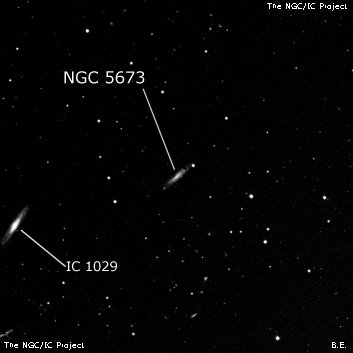
John Herschel discovered NGC 5673 = h1838 on 13 May 1830 and recorded "vF; pmE; sf a star 15m." He assumed h1838 was a reobservation of his father's II-696, a brighter edge-on 10' east-southeast (UGC 9361). JH used his position for II-696 in the GC and Dreyer copied this into the NGC. In his 1912 Scientific Papers of WH, Dreyer wrongly assumed that WH's position was incorrect: "the transit must have been entered 1 tmin too late". Because of the error in the NGC position, when Bigourdan observed the pair on 14 Jun 1887, he assumed II-696 was new, measured an accurate position, and Dreyer catalogued it as IC 1029.
Harold Corwin feels it is wisest to keep NGC 5673 assigned to fainter UGC 9347, to conform to the current catalogues as well as the GC and NGC. So, NGC 5673 = h1838 = UGC 9347 and IC 1029 = H II-696 = B. 185 =(UGC 9361, an unusual situation in which an IC object was discovered by WH! On the other hand, Malcolm Thomson argues NGC 5673 should apply to WH's II-696 =(UGC 9361, though in this case UGC 9347 would not receive a NGC or IC number.
400/500mm - 17.5" (6/24/95): faint, edge-on 5:1 NW-SSE, 2.2'x0.4'. NGC 5673 has similar dimensions and position angle as IC 1029 9.7' ESE but doesn't contain a bright core so is not nearly as prominent in the same field. A mag 13.5 star is at the NW tip 1.1' from center. IC 1029 = UGC 9361 appeared moderately bright, edge-on 5:1 NNW-SSE, 2.0'x0.4'. Contains a very small and round prominent core with a faint stellar nucleus at moments. Located 3.2' W of a mag 9.5 star.
Notes by Steve Gottlieb